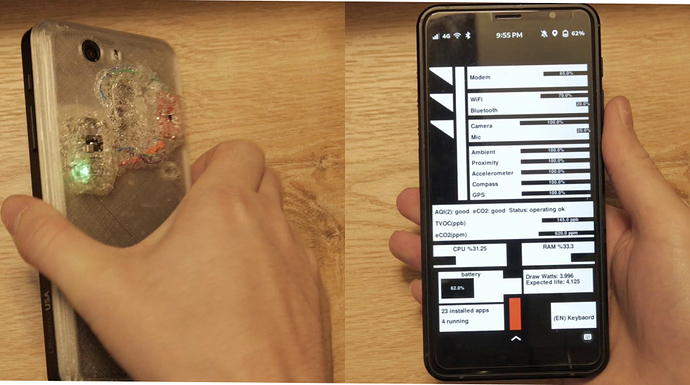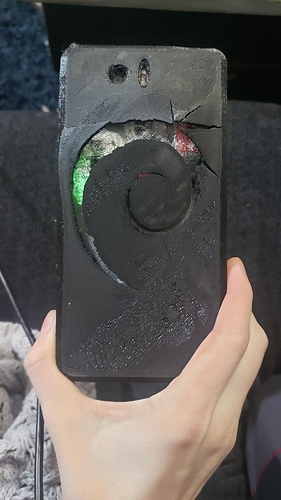The breakout board for the Librem 5 is a great way for hardware hackers to add functionality to your phone. When attached, you’ll have nicely exposed programmable pins. This allows you to use I2C, serial, and many digital sensors, much like you would on a single-board microcomputer.
I imagine the security staff at the airport looking at my transparent custom case accommodating the extra boards. 
Just when I thought that I had enough phones, you make it into a great (although pricey) maker platform. A Raspberry Pi with a clock, touchscreen, battery backup, and cell modem would be a bit cheaper, but being phone sized helps with some types of projects that require that things be compact. It is also nice to have all of these things already put together so that I can focus on the project.
The gas sensor example reminds me of this frivolous project:
This is what it ended up looking like when my wife takes it out and about. She can’t smell so I added a script that alerts her when the air gets too bad.
Impressive, David!
I did not knew that the project was not just for fun, but it actually serves purpose.
Great work and thank you for sharing.
The mutating Debian optic is definitely a statement. I like it.
![]()
Librem 5 … the phone for death metal aficionados?
What can possible to do with it? I read the explanation on Purism shop but I didn’t understand it! 
Thank you
You can add additional hardware to the Librem 5.
Main example is additional sensors.
In the example given by Purism, David added an air quality sensor to the Librem 5.
This is a very interesting feature of Librem 5 because you can’t do such stuff with an Android or an iPhone. There you buy what you buy and can’t expand it.
On the market you have a variety of sensors available, because people buy such electronic components for years and use them in combination with Raspberry Pi or with microcontrollers. So you can have a smartphone with a sonar. Or a smartphone with the ability to measure your blood oxygen levels. Or a smartphone that has an infrared sender and could be used instead of your TV remote control.
And the use case of David shows that there are really meaningful use cases and not just for fun.
This may start you off: https://source.puri.sm/Librem5/community-wiki/-/wikis/Frequently-Asked-Questions#215-where-are-the-librem-5s-20-test-points-and-24-pin-external-connector (see the section on the External Connector)
I think in the blog post it shows connecting a sensor that provides an I2C interface but presumably any I2C device could be connected. It also talks about a serial connector (UART) which would be usable with a range of devices.
PS You will note that the external connector has some pins with name containing “NFC”. So maybe in the future it will be possible to support NFC e.g. for payment or authentication or transport, maybe even very short-range / low bandwidth networking.
That’s just how the signals are named in the schematics. I believe they are leftovers from NFC being initially considered as a feature, but since it was eventually scrapped they got redirected to the extension connector. You could attach some NFC circuit to it and make it work, but you could attach anything else just as well. After all, these are just generic GPIO lines.
You also get SPI.
Out of stock now. Was hoping to get one with my phone. 
This is super cool, but I can’t help but think it would be almost impossible to daily drive this with a modified case. I think the best way you could do this is to extend those headers so its flush with the back of the case. Then you could just create a bunch of modules you could plug in without taking the back off. This would of course require cutting a hole in the back of your phone… I’ll be interested to see what people come up with.
Actually the Librem 5 design is quite clever in this regard.
The back of Librem 5 is a simple plastic cover. So anybody could 3D print their own back plastic covers with modifications to accommodate for different extensions and then you change the whole back cover when you need to carry the extension with you. No need of destroying the original cover. You could just put it in the drawer for the days when you carry your phone without extensions.
I am not sure if Purism have already published the necessary files for printing the back cover so that people who want to do modifications have an easier time. If this is not public yet, I would definitely welcome if they do it public. Don’t see much financial damage in people being able to print the plastic back cover themselves.
Very true. If you’re buying the board, you likely have a printer. Certainly applies to me. I guess I want expandability and a back cover that still feels nice. So when I’m not using the slot I could just plug up the hole.
How long until new boards arrive? I’m needing one to develop something
Best to support@puri.sm
I’ll shoot an email their way in a few.

